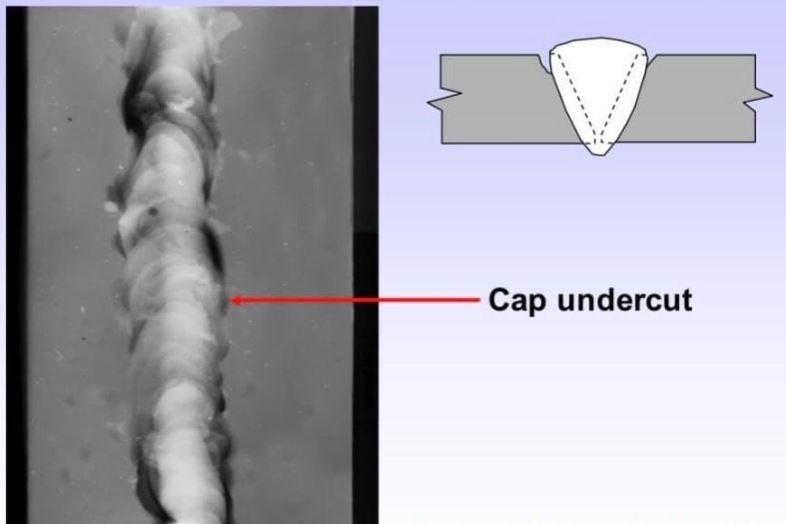Preventing Weld Undercut Made Easy: Key Techniques Unveiled
Preventing Weld Undercut Made Easy: Key Techniques Unveiled
Blog Article
Important Tips for Welders: Stopping Undercut Welding and Ensuring Stronger Weld Joints
In the realm of welding, accomplishing strong and durable weld joints is the foundation of creating premium job. One usual difficulty that welders typically experience is undercut welding, which can compromise the honesty of the weld joint.

Comprehending Undercut Welding
Undercut welding is a common welding issue that occurs when the weld steel fails to properly fill up the groove and leads to a groove-like anxiety along the weld bead. This defect compromises the weld joint, making it at risk to breaking and failure under anxiety. Damaging can be caused by different variables, including extreme welding existing, high welding speed, incorrect electrode angle, wrong electrode dimension, and poor welding method.
Among the main factors for undercut welding is an imbalance between the welding existing and the welding rate. If the welding current is too high or the welding speed is too quick, the weld steel might not sufficiently load the groove, leading to undercutting. Furthermore, using an electrode that is also huge can cause a similar outcome, as the excess metal can not correctly stream into the groove.
To stop undercut welding, welders must guarantee they are making use of the correct welding parameters, maintain an appropriate electrode angle, pick the appropriate electrode size, and technique appropriate welding methods. By resolving these elements, welders can decrease the threat of damaging and produce more powerful, a lot more trustworthy weld joints.
Correct Welding Technique
Efficient welding technique plays a crucial role in ensuring the top quality and stability of weld joints. One fundamental facet of appropriate welding strategy is preserving the correct angle and range in between the welding weapon and the workpiece.
Furthermore, a consistent and consistent hand activity is vital for creating strong and durable weld joints. Welders must intend for smooth, consistent motions to guarantee also distribution of the weld product. Appropriate adjustment of the welding weapon and filler product is likewise vital to accomplishing optimum penetration and combination.
Furthermore, controlling the warmth input and selecting the proper welding parameters based on the product being bonded are vital consider achieving high-grade welds - Preventing weld undercut. Welders ought to comply with the advised settings offered by welding treatment specs and readjust them as needed based on the certain needs of the project. By grasping appropriate welding methods, welders can considerably boost the toughness and reliability of their weld joints
Selecting the Right Electrode
Preserving the proper angle and distance in between the welding weapon and the work surface is fundamental when considering the significance of selecting the appropriate electrode in welding applications. The choice of electrode plays a vital function in establishing the top quality and toughness of the weld joint. Electrodes come in various kinds, each designed for specific purposes and products.
To start with, picking the appropriate electrode diameter is important. Thinner electrodes appropriate for welding thin products, while thicker electrodes are much better for thicker products and greater warm applications. Matching the electrode size to the density of the workpiece aids attain a well balanced weld.
Second of all, understanding the product make-up of the electrode is vital. Various electrodes are designed for welding specific products like steel, stainless-steel, light weight aluminum, or cast iron. Using the proper electrode material makes certain great blend and lessens the threat of issues in the weld.
Finally, thinking about the welding position and method is critical when choosing the electrode type. For example, particular electrodes are much better matched for overhanging or vertical welding settings, while others function well for level or straight positions. Choosing the right electrode based upon the welding technique boosts the total check out this site weld high quality and integrity.
Preparing the Base Steel
To ensure an effective welding process, what initial steps should be taken when preparing the base steel for click for more welding? In addition, any kind of existing weld product or residue from previous welding need to be gotten rid of to make certain a tidy surface for the brand-new weld.

Performing Post-Weld Examinations

After carrying out these analyses, welders must contrast the outcomes versus market requirements and task requirements to make sure that the weld joint satisfies all required standards. Any kind of inconsistencies or insufficiencies found during the post-weld examination ought navigate to this site to be immediately addressed with appropriate corrective procedures to assure the weld's honesty. By faithfully doing post-weld inspections and quickly resolving any kind of issues, welders can support the quality and dependability of their job, eventually adding to the security and durability of the welded frameworks.
Final Thought

To conclude, preventing undercut welding and guaranteeing stronger weld joints need a combination of correct welding technique, choosing the best electrode, preparing the base steel appropriately, and performing post-weld inspections. By comprehending the root causes of undercut welding and carrying out the required safety measures, welders can create top notch weld joints that meet market criteria and guarantee the structural stability of the welded elements.
Undercut welding is a common welding defect that happens when the weld metal stops working to correctly load the groove and results in a groove-like clinical depression along the weld bead (Preventing weld undercut). Damaging can be created by different aspects, consisting of extreme welding present, high welding rate, improper electrode angle, incorrect electrode dimension, and poor welding method
One of the major reasons for undercut welding is an imbalance in between the welding current and the welding rate. If the welding current is as well high or the welding speed is also quickly, the weld metal may not effectively fill up the groove, leading to damaging.Preserving the right angle and range in between the welding weapon and the workpiece is fundamental when considering the importance of choosing the ideal electrode in welding applications.
Report this page